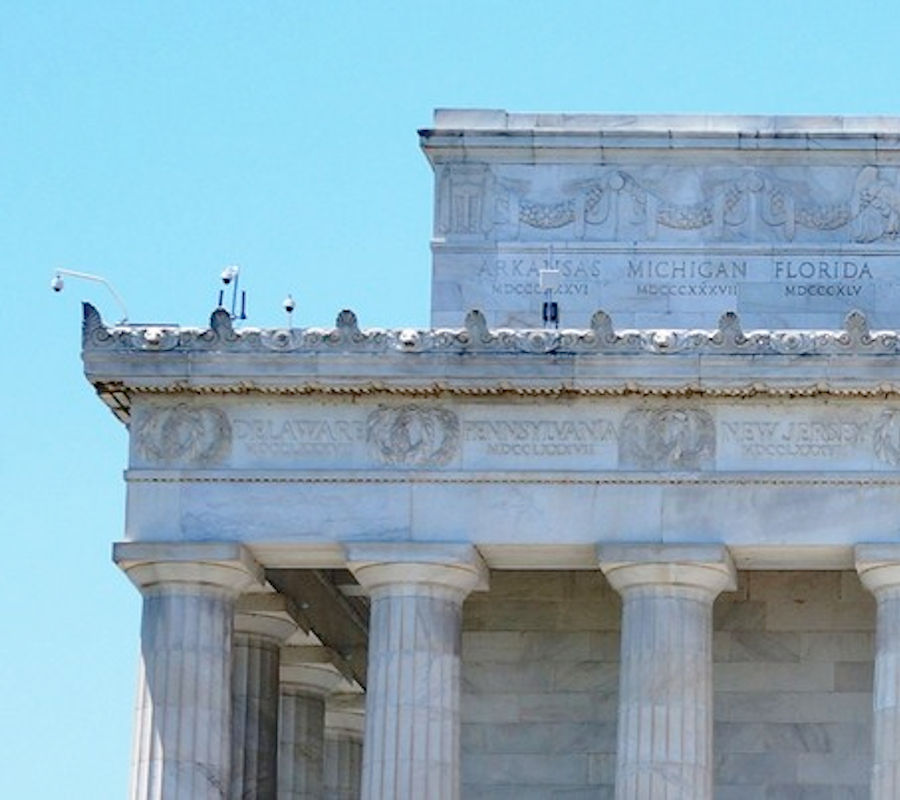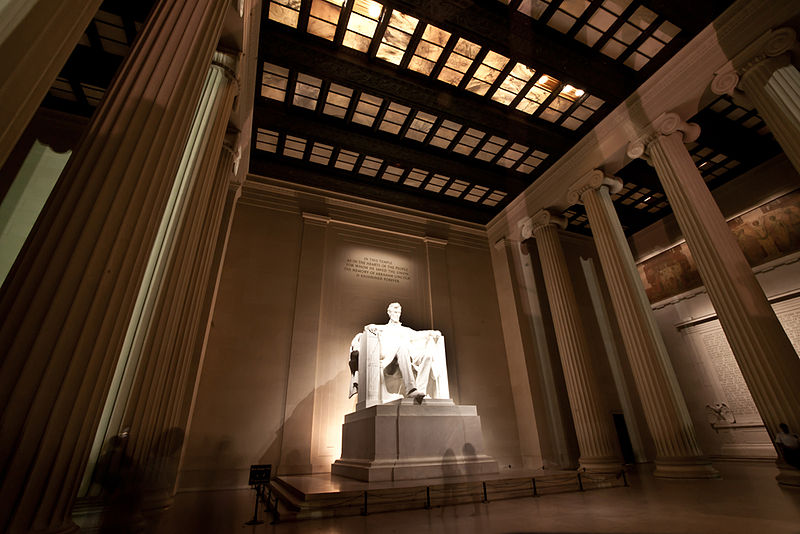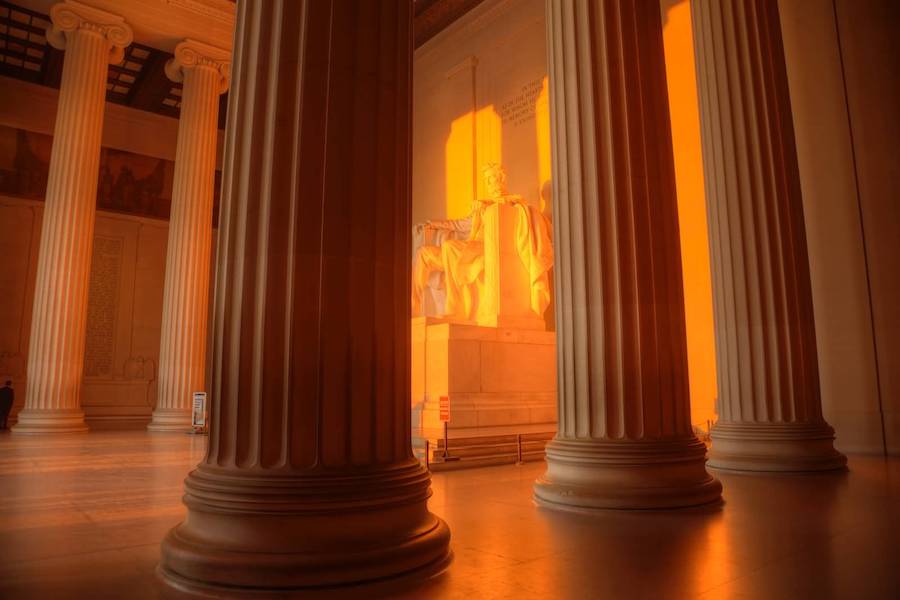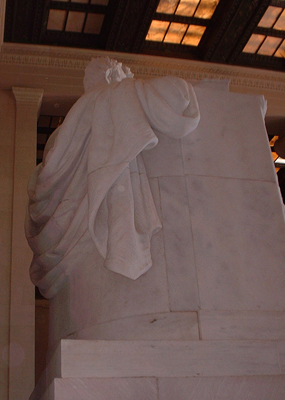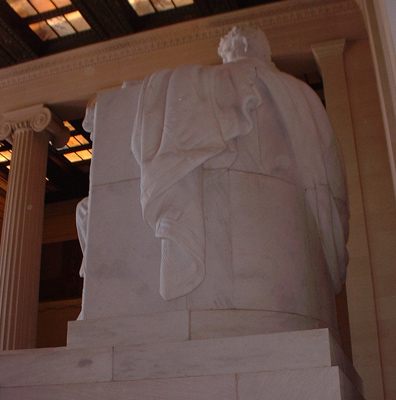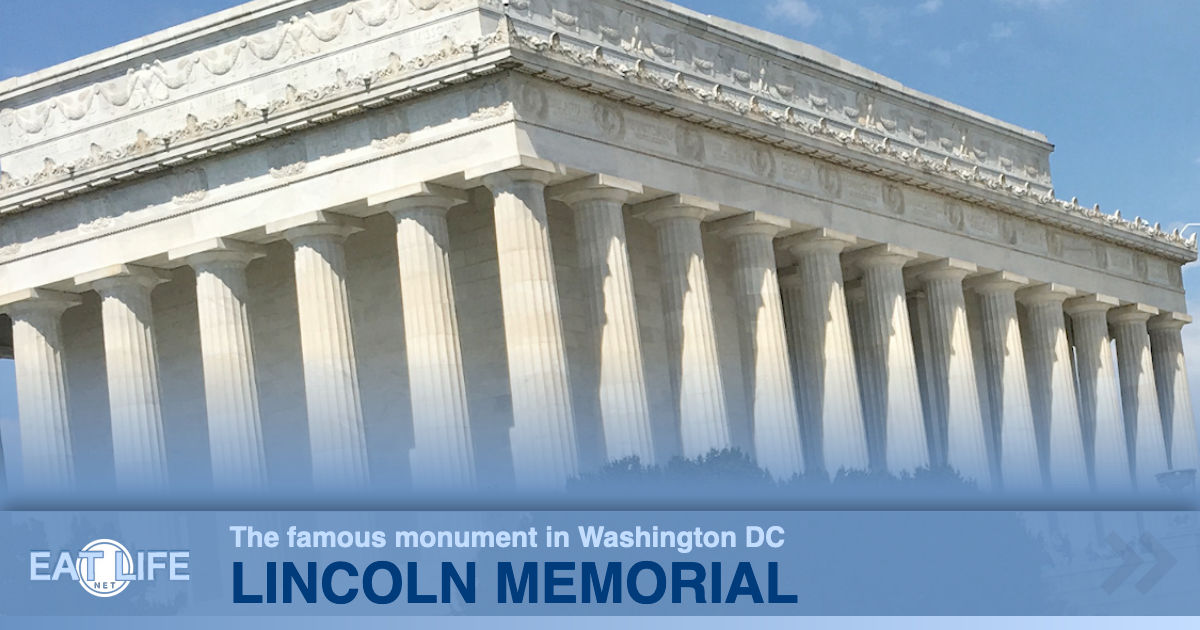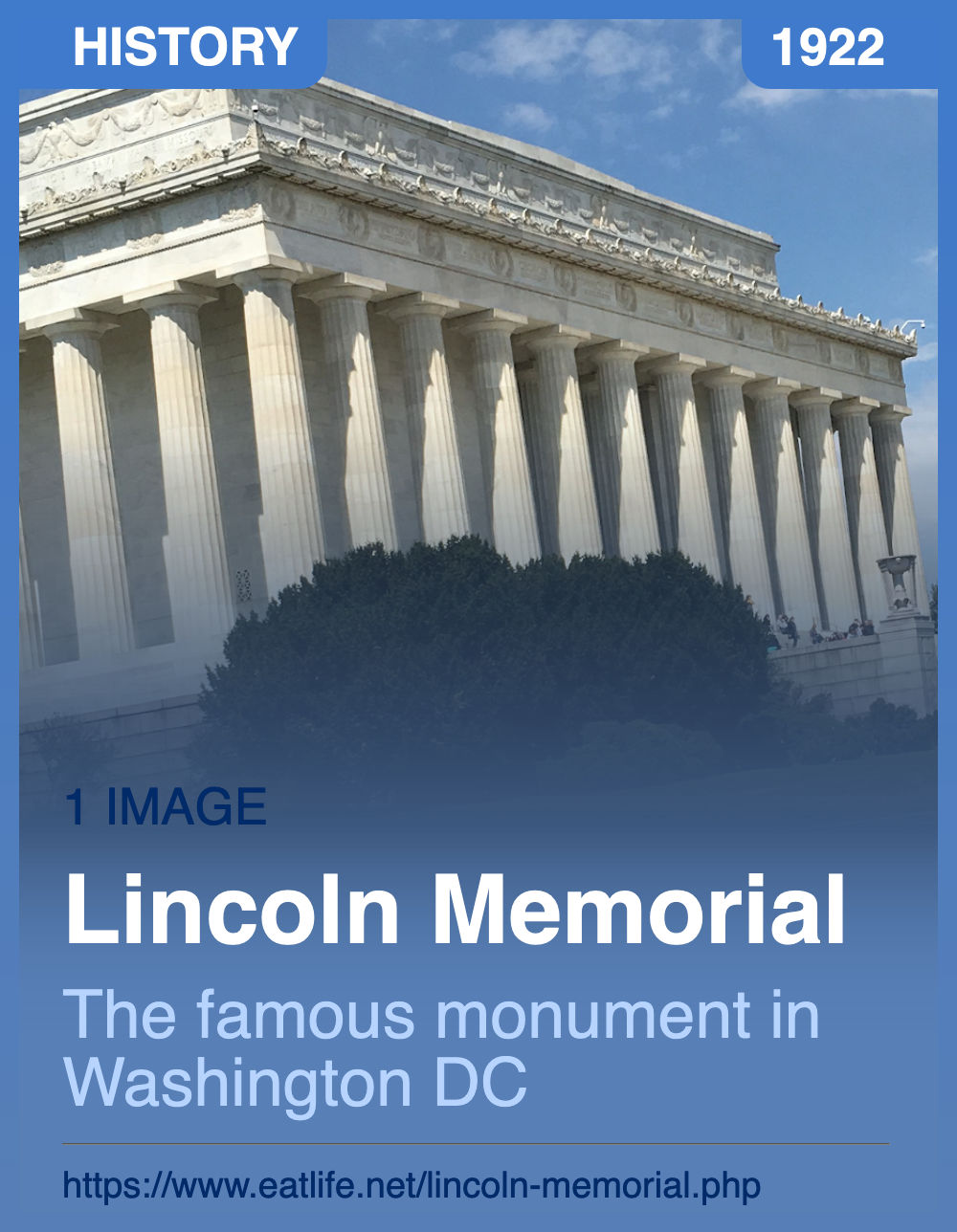Lincoln Memorial
There are 36 columns, each one representing one state in the U.S. at the date of President Lincoln's death. The memorial itself is 190 feet long and 119 feet wide, and reaches a height of almost 100 feet.Climb the stairs leading to the interior, and look up. There, etched into the wall, is a memorable quote:
In this temple, as in the hearts of the people for whom he saved the Union, the memory of Abraham Lincoln is enshrined forever.Below the quote sits a 19-foot tall, 175-ton statue of President Lincoln, himself looking out over the Mall of the country that he fought so hard to preserve and unite. The statue was designed by Daniel Chester French, who worked to depict Lincoln during the Civil War, stately and dignified. Interestingly, though the memorial was approved decades earlier, construction did not begin until 1914, and the memorial opened to the public in 1922.
To the left of the statue is Lincoln's great speech, the Gettysburg Address, one of the most famous in U.S. history. Every single word of the address is etched into the wall to inspire Americans just as it did in 1863. To the right is the entire Second Inaugural Address, given in March of 1865 - mere months before Lincoln's death.
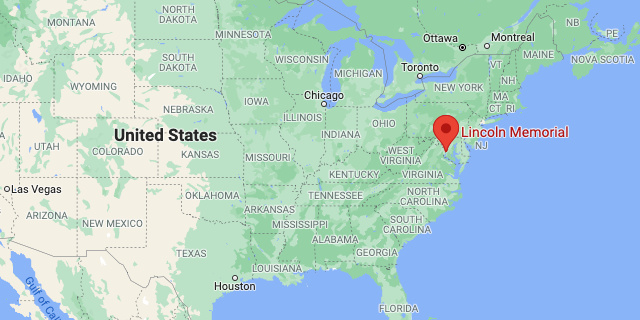
https://www.google.com/maps/place/Lincoln+Memorial,+Washington,+DC
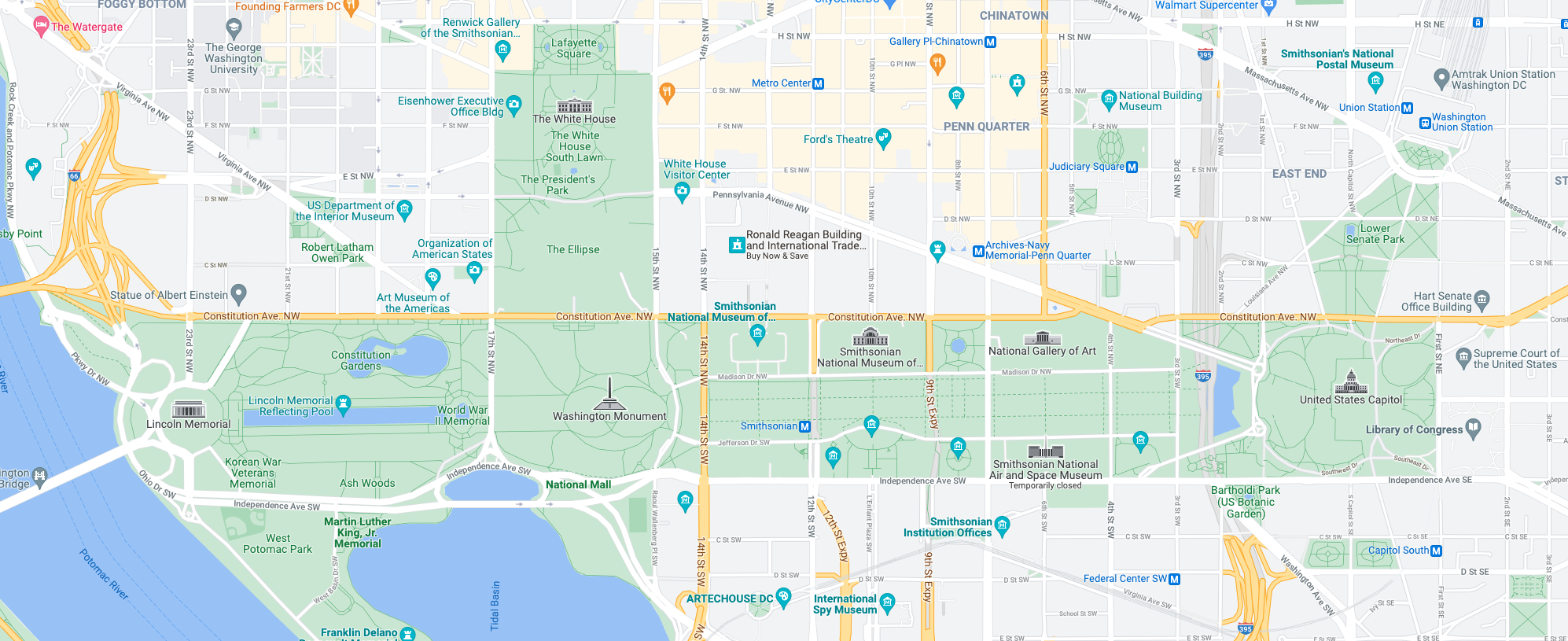
https://www.google.com/maps/place/National+Mall
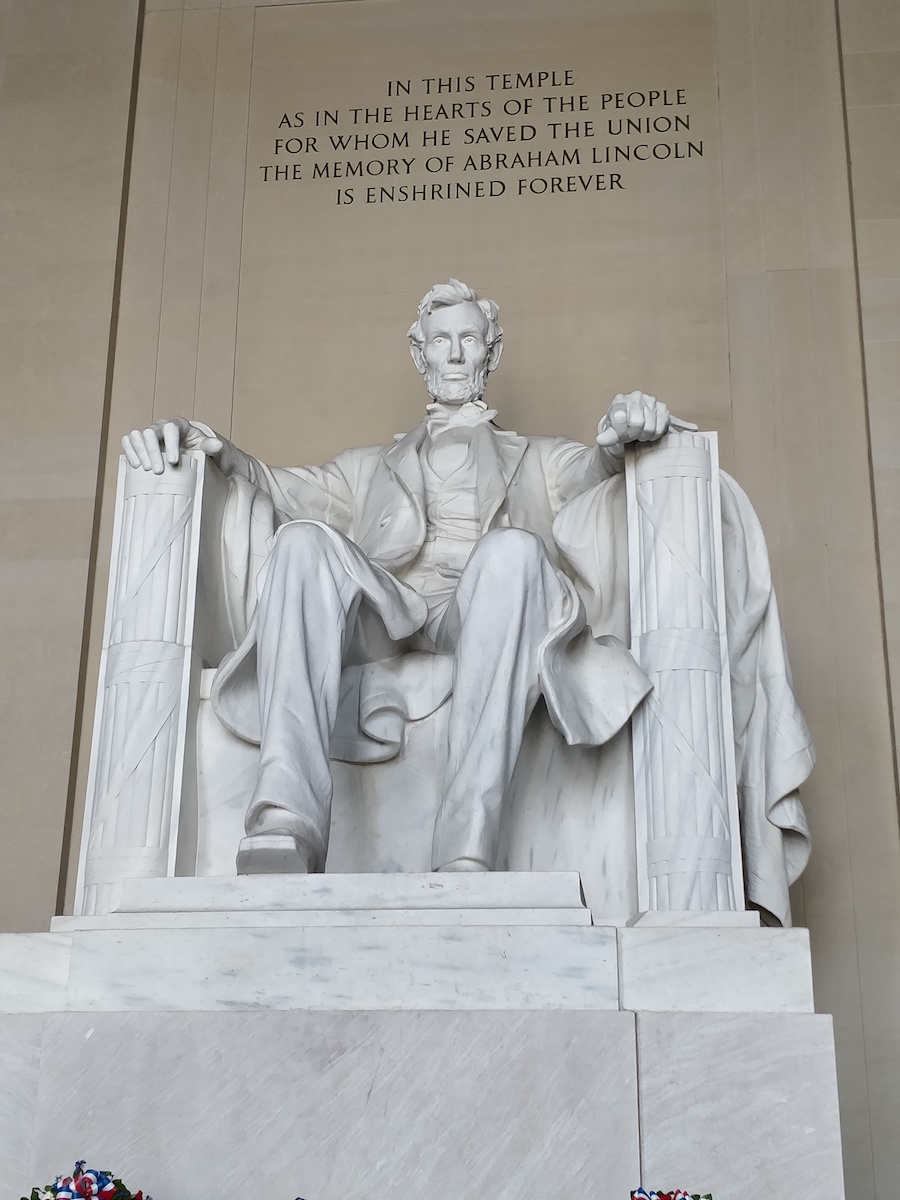
In this temple as in the hearts of the people for whom he saved the Union, the memory of Abraham Lincoln is enshrined forever
https://blogs.loc.gov/law/2020/05/the-lincoln-memorial-pic-of-the-week
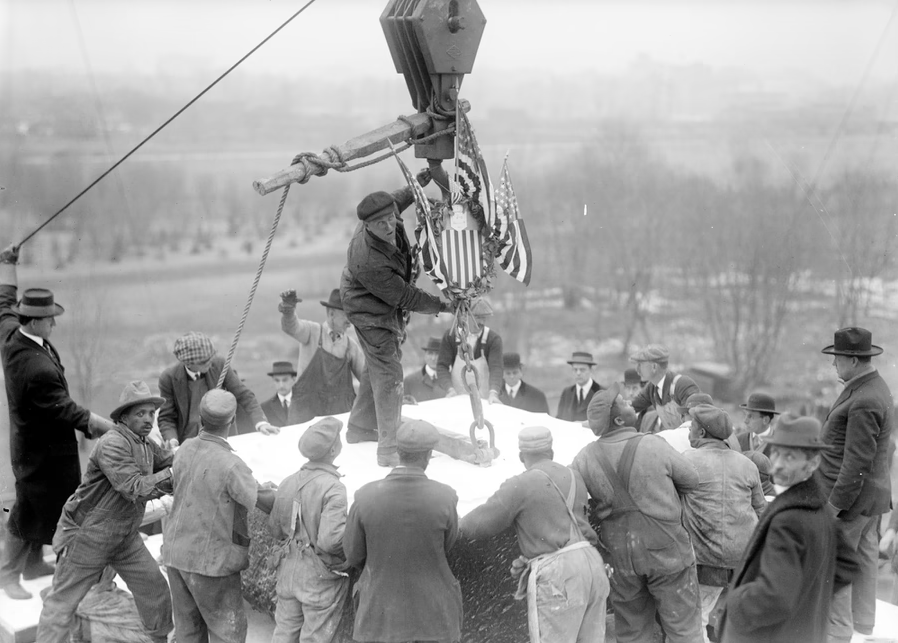
Under construction:
https://www.theatlantic.com/photo/2016/02/historic-photos-of-the-lincoln-memorial/462990
The 36 columns in place, work is underway on the frieze, where the names of the 36 states in the Union at the time of Lincoln's death are inscribed, photographed in 1915:
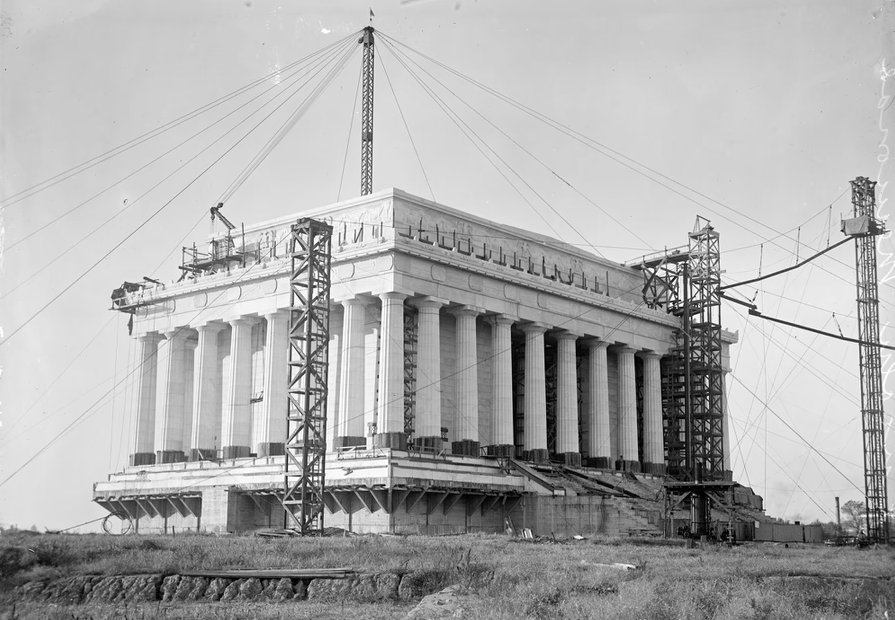
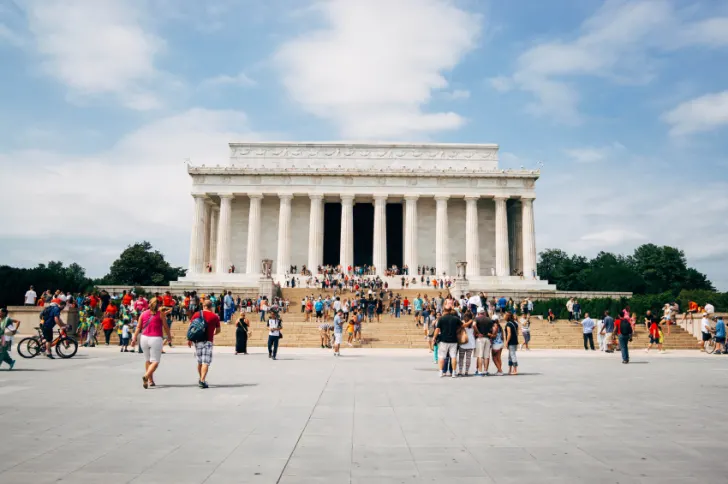
When viewers bask in the 99-foot-tall, 202-foot-wide Lincoln Memorial, they're really only seeing a little more than half of the construction. Rooted beneath the ground is the piece's foundation, which extends 66 feet into the earth at its deepest point to support the weight of the marble structure.
https://www.mentalfloss.com/article/66932/15-monumental-facts-about-lincoln-memorial
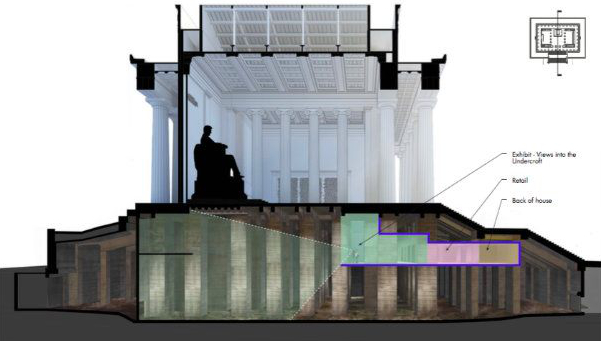
Construction began on the Lincoln Memorial in 1914 on the muddy stretch of land known as the Potomac flats. The Army Corps of Engineers had just finished its 40-year-long dredging and landfill project that produced the shoreline we know today. Workers had to dig down 40 feet before work could begin on the marble monument. Here they poured dozens of concrete columns to support the surface structure. The underground cathedral of concrete pillars was then simply forgotten about until renovations in 1975.

For a time, the National Park Service offered flashlight tours of the Undercroft, but they were abruptly halted in 1989 when a tourist noticed asbestos and flagged it for authorities.
NPS now wants to rehab and open up the Undercroft in time for the Lincoln Memorial's centennial in 2022. Their proposal to the National Capital Planning Commission includes a rendering showing a platform floating out into the underground space that will allow visitors to get a look at the columns and graffiti.
One other interesting find was historical graffiti from way back in 1914:
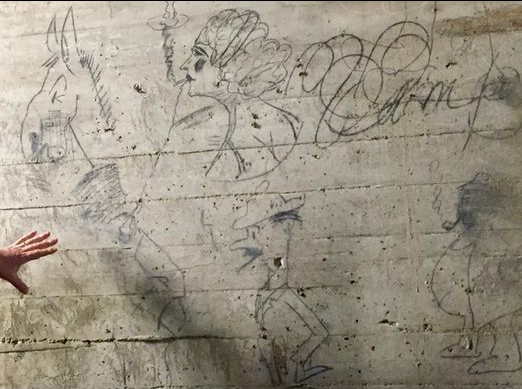
The builders actually drew cartoons and they have them covered in Plexiglas.
https://www.atlasobscura.com/places/lincoln-memorial-undercroft
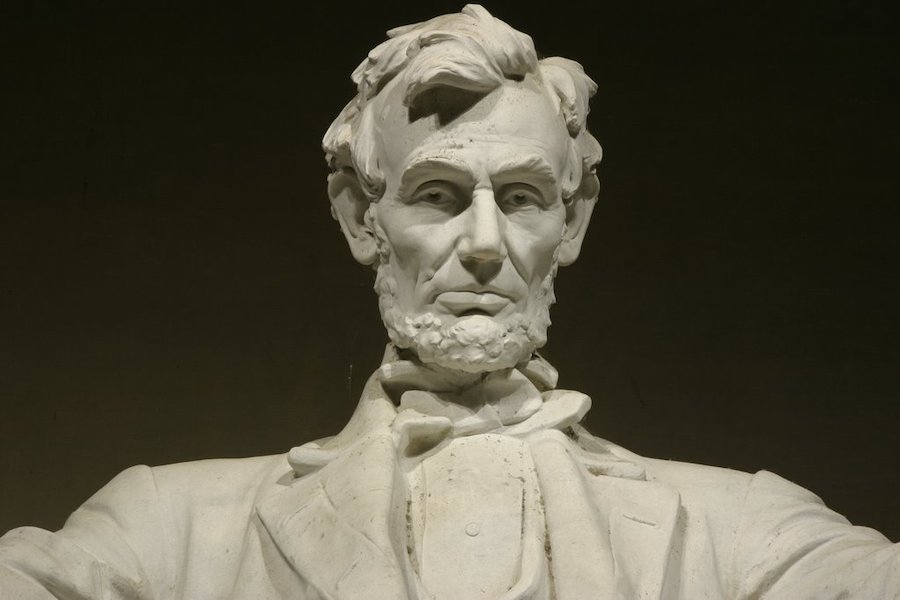
Inside the main hall is placed a statue of Lincoln sitting. This statue was carved by Piccirili brothers and supervisor Daniel Chester French. Lincoln statue as high as 5.8 m. This statue is made of carved marble Georgia, the overall weight of 159 tons and had to be transported in 28 separate parts. This statue is placed on a stand rectangular marble Tennessee with a height 3.0 m and a width of 4.9 m and a depth of 5.2 m. Lincoln arm leaning on the chair arm bearing the Roman fasces.
https://traveldigg.com/lincoln-memorial
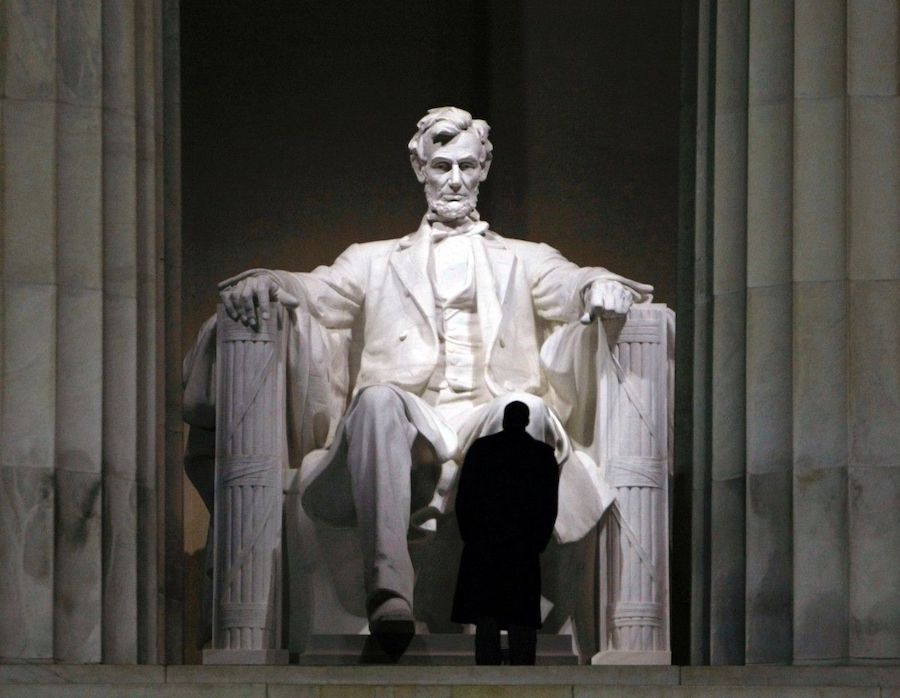
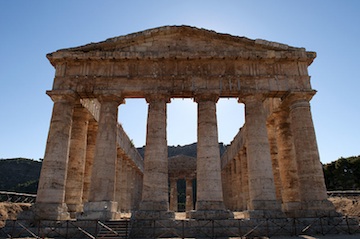 Greek Doric Temple:
Greek Doric Temple:The Doric Order of Greek architecture was the first style of stone temple architecture in ancient Greece. It became popular in the Archaic Period, roughly 750-480 BCE, and replaced the previous style of basic, wood structures. The Doric Order was the first style of Classical Architecture, which is the sophisticated architectural styles of ancient Greece and Rome that set the standards for beauty, harmony, and strength for European architecture. The other two orders are Ionic and Corinthian.
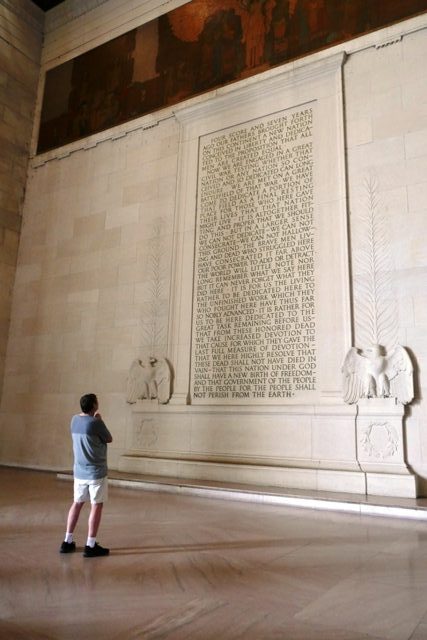
Four score and seven years ago our fathers brought forth on this continent, a new nation, conceived in Liberty, and dedicated to the proposition that all men are created equal.Now we are engaged in a great civil war, testing whether that nation, or any nation so conceived and so dedicated, can long endure. We are met on a great battle-field of that war. We have come to dedicate a portion of that field, as a final resting place for those who here gave their lives that that nation might live. It is altogether fitting and proper that we should do this.
But, in a larger sense, we can not dedicate—we can not consecrate—we can not hallow—this ground. The brave men, living and dead, who struggled here, have consecrated it, far above our poor power to add or detract. The world will little note, nor long remember what we say here, but it can never forget what they did here. It is for us the living, rather, to be dedicated here to the unfinished work which they who fought here have thus far so nobly advanced. It is rather for us to be here dedicated to the great task remaining before us—that from these honored dead we take increased devotion to that cause for which they gave the last full measure of devotion—that we here highly resolve that these dead shall not have died in vain—that this nation, under God, shall have a new birth of freedom—and that government of the people, by the people, for the people, shall not perish from the earth.
https://sarahjmccabe.com/revisiting-the-lincoln-memorial-and-the-gettysburg-address
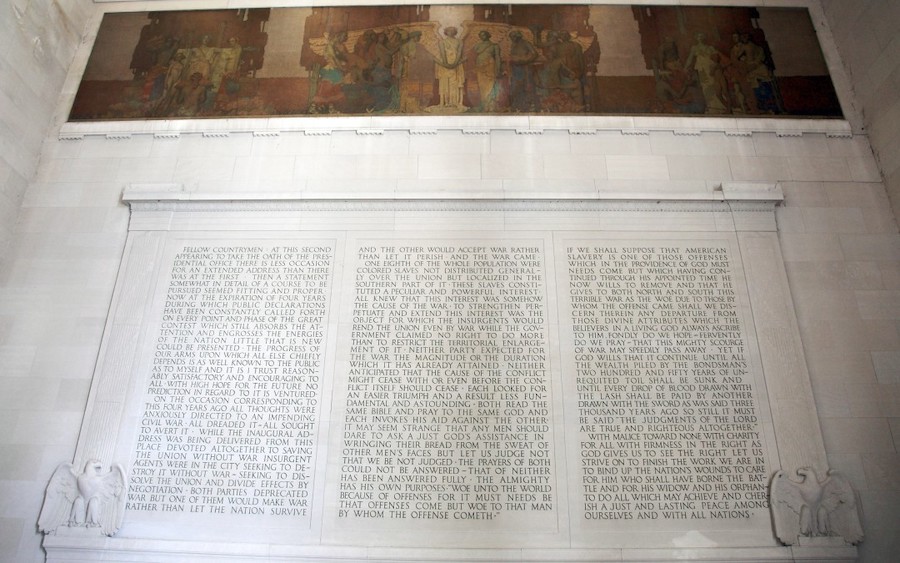
One of the most striking, peculiar, and somber of all presidential speeches: Lincoln's Second Inaugural Address, delivered March 4, 1865, etched forever on the wall of the Lincoln Memorial.
https://speakeasyideas.com/comedy-tragedy-lincolns-inaugural-addresses
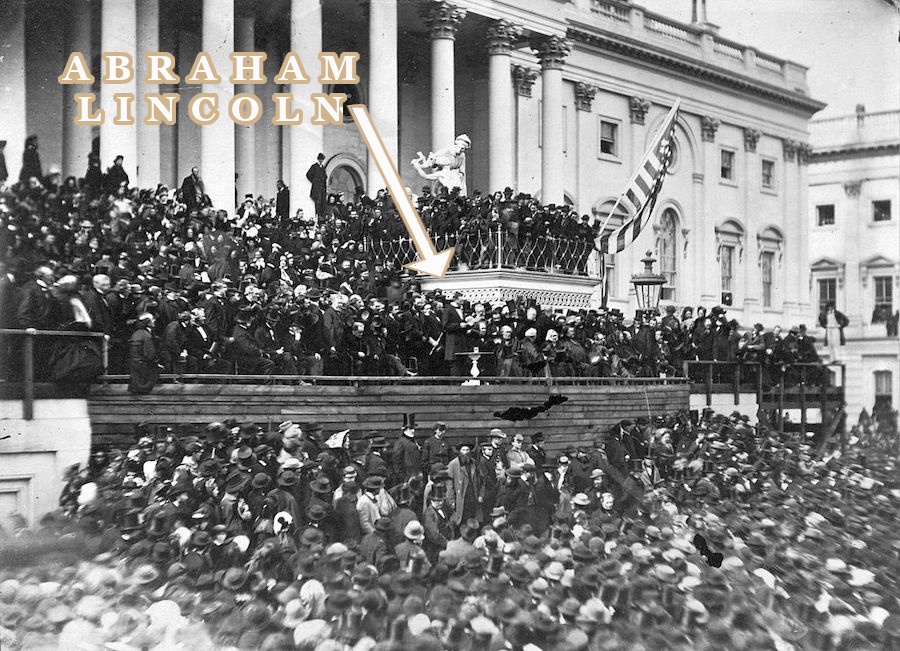
Fellow-Countrymen:At this second appearing to take the oath of the Presidential office there is less occasion for an extended address than there was at the first. Then a statement somewhat in detail of a course to be pursued seemed fitting and proper. Now, at the expiration of four years, during which public declarations have been constantly called forth on every point and phase of this great conflict which is of primary concern to the nation as a whole, little that is new could be presented. The progress of our arms, upon which all else chiefly depends, is as well known to the public as to myself, and it is, I trust, reasonably satisfactory and encouraging to all. With high hope for the future, no prediction in regard to it is ventured.
On the occasion corresponding to this four years ago all thoughts were anxiously directed to an impending civil war. All dreaded it, all sought to avert it. While the inaugural address was being delivered from this place, devoted altogether to saving the Union without war, insurgent agents were in the city seeking to destroy it without war—seeking to dissolve the Union and divide effects by negotiation. Both parties deprecated war, but one of them would make war rather than let the nation survive, and the other would accept war rather than let it perish. And the war came.
One-eighth of the whole population were colored slaves, not distributed generally over the Union, but localized in the southern part of it. These slaves constituted a peculiar and powerful interest. All knew that this interest was somehow the cause of the war. To strengthen, perpetuate, and extend this interest was the object for which the insurgents would rend the Union even by war, while the Government claimed no right to do more than to restrict the territorial enlargement of it. Neither party expected for the war the magnitude or the duration which it has already attained. Neither anticipated that the cause of the conflict might cease with or even before the conflict itself should cease. Each looked for an easier triumph, and a result less fundamental and astounding. Both read the same Bible and pray to the same God, and each invokes His aid against the other. It may seem strange that any men should dare to ask a just God's assistance in wringing their bread from the sweat of other men's faces, but let us judge not, that we be not judged. The prayers of both could not be answered. That of neither has been answered fully. The Almighty has His own purposes. "Woe unto the world because of offenses; for it must needs be that offenses come, but woe to that man by whom the offense cometh." If we shall suppose that American slavery is one of those offenses which, in the providence of God, must needs come, but which, having continued through His appointed time, He now wills to remove, and that He gives to both North and South this terrible war as the woe due to those by whom the offense came, shall we discern therein any departure from those divine attributes which the believers in a living God always ascribe to Him? Fondly do we hope, fervently do we pray, that this mighty scourge of war may speedily pass away. Yet, if God wills that it continue until all the wealth piled by the bondsman's two hundred and fifty years of unrequited toil shall be sunk, and until every drop of blood drawn with the lash shall be paid by another drawn with the sword, as was said three thousand years ago, so still it must be said "the judgments of the Lord are true and righteous altogether."
With malice toward none, with charity for all, with firmness in the right as God gives us to see the right, let us strive on to finish the work we are in, to bind up the nation's wounds, to care for him who shall have borne the battle and for his widow and his orphan, to do all which may achieve and cherish a just and lasting peace among ourselves and with all nations.
https://en.wikipedia.org/wiki/Abraham_Lincoln%27s_second_inaugural_address

The United States Mint first made the Lincoln penny in 1909 to celebrate the 100th anniversary of the birth of President Abraham Lincoln. The coin has a reverse design that features two ears of wheat. In 1959 the Mint celebrated the 50th anniversary of the Lincoln penny by changing the reverse design to feature a rendition of the Lincoln Memorial. Mint engraver Frank Gasparro designed this new reverse. Additionally, this also commemorated the 150th anniversary of Abraham Lincoln's birth.
In the middle of the penny, inside the Lincoln Memorial, you can see the statue of Lincoln
In 2009, to commemorate the 200th anniversary of Lincoln's birth, four different reverse designs were featured. Finally, in 2010 the reverse was changed to feature a representation of the Union Shield in the center of the coin.
https://www.thesprucecrafts.com/lincoln-memorial-penny-values-4058898
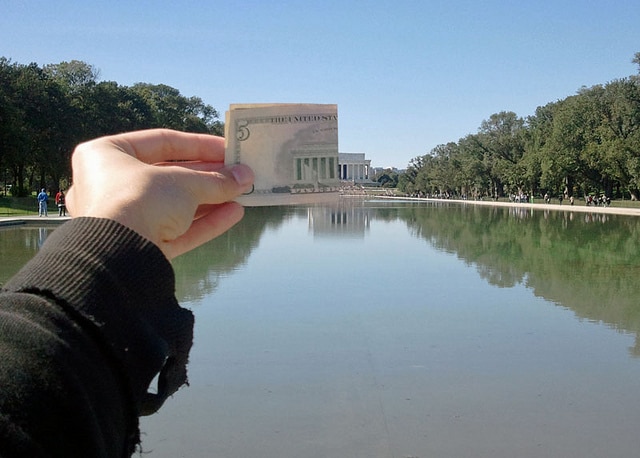
https://quirkytravelguy.com/quirky-fun-facts-washington-dc-monuments-memorials

The Rev. Dr. Martin Luther King Jr., head of the Southern Christian Leadership Conference, spoke to thousands during his "I Have a Dream" speech in front of the Lincoln Memorial for the March on Washington for Jobs and Freedom.
We too often eulogize the Rev. Dr. Martin Luther King Jr. by repeating out-of-context quotes or fragmented lines from his greatest speeches. This address, given on the steps of the Lincoln Memorial at the 1963 March on Washington for Jobs and Freedom, is recognizable to many but studied and internalized by few.
I am happy to join with you today in what will go down in history as the greatest demonstration for freedom in the history of our nation.Five score years ago, a great American, in whose symbolic shadow we stand today, signed the Emancipation Proclamation. This momentous decree came as a great beacon light of hope to millions of Negro slaves who had been seared in the flames of withering injustice. It came as a joyous daybreak to end the long night of their captivity.
Link to the entire speech:
https://www.deseret.com/opinion/2021/1/17/22232909/the-rev-dr-martin-luther-king-jr-i-have-a-dream-speech-march-on-washington-1963-mlk-day
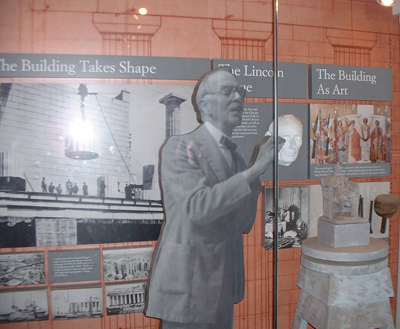
In the basement of the Lincoln Memorial, the National Park service has assembled an exhibit about the Lincoln Memorial which includes this full size photo of Daniel Chester French and a small model of his statue of Lincoln.
Daniel Chester French was the sculpter who carved the statue of Lincoln sitting. This is what the statue looks like from the back sides:
http://www.yeodoug.com/resources/dc_french/lincoln_memorial/dcfrench_lincoln_memorial.html
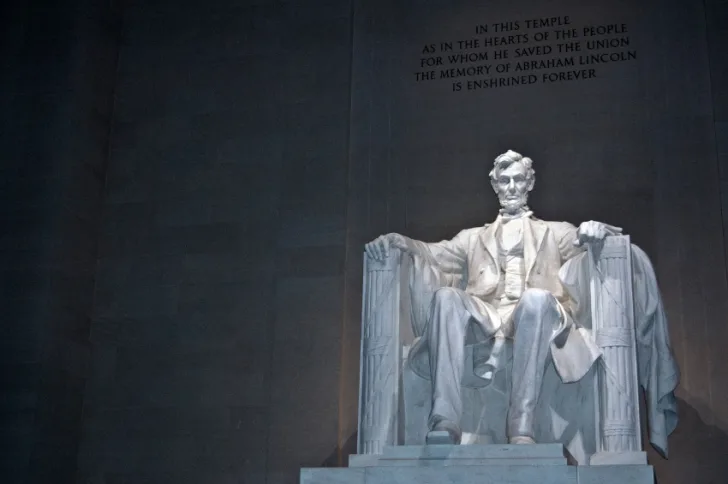
French's initial blueprints included a 10-foot Lincoln. As not to see the President outdone by the grandeur of Bacon's surrounding hall, French bulked Honest Abe up to a more majestic height of 19 feet.
https://www.mentalfloss.com/article/66932/15-monumental-facts-about-lincoln-memorial
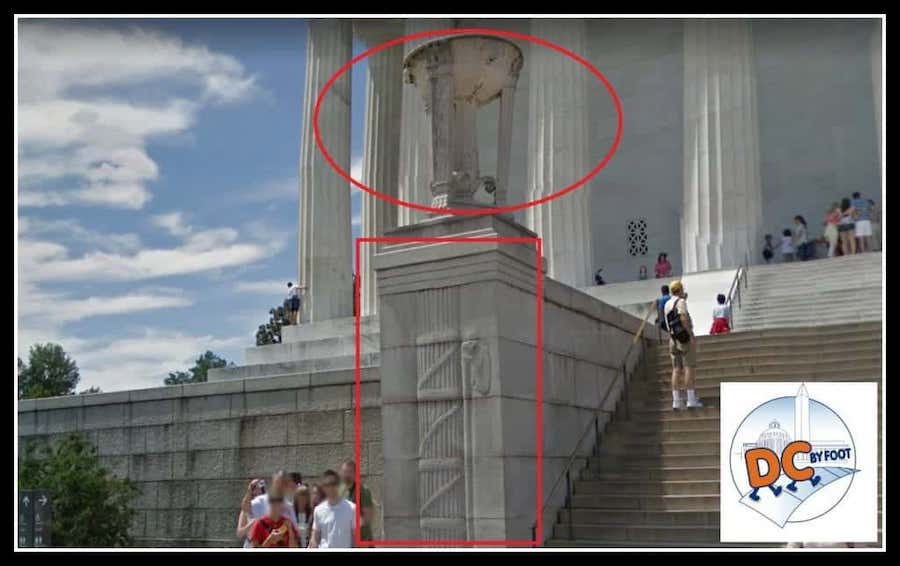
Most visitors to the memorial will go straight inside, totally oblivious to features of the memorial hidden in plain sight. However, these are actually important symbols.
They are Roman fasces, wooden rods tied together by leather, and the victory tripods found on both sides of the grand staircase.
The first was a symbol of authority for Roman magistrates and were included to convey a similar executive authority of Lincoln.
The fasces found on the exterior of the memorial has an American flair with 13 rods (13 colonies) and an American bald eagle atop the ax.
The fasces is also a symbol of unity; the individual rods, like the states, are weak, but unified, they are strong.
In fact, this symbol of the fasces is so important, you will also see them inside on the walls and on the Lincoln statue itself.
During World War 2, fasces would be very controversial, as the fascist government of Italy would choose fasces for both their name and flag.
The second is the victory tripods, an ancient Roman symbol of victory. These are adorned with Americana, tobacco, corn, and eagles.
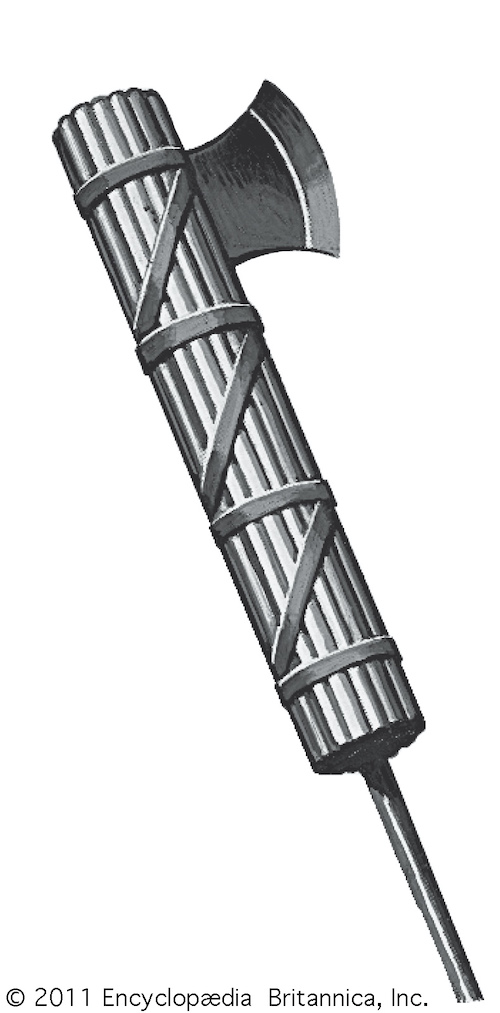 Fasces: Latin for "bundle". It was the insignia of official authority in ancient Rome.
Fasces: Latin for "bundle". It was the insignia of official authority in ancient Rome.
The fasces was carried by the lictors, or attendants, and was characterized by an ax head projecting from a bundle of elm or birch rods about 5 feet long and tied together with a red strap; it symbolized penal power.
Benito Mussolini's Fascist Party of Italy was named for the fasces, which the members adopted in 1919 as their emblem.

Fasces imply power, strength, authority, and justice. In ancient times, fasces were a Roman symbol of power and authority, a bundle of wooden rods and an axe bound together by leather thongs. Fasces represented that a man held imperium, or executive authority. Exercising imperium, a Roman leader could expect his orders to be obeyed, could dole out punishment, and could even execute those who disobeyed. The fasces he carried symbolized this power in two ways: the rods suggest punishment by beating, the axe suggests beheading. On its surface, the fasces imply power, strength, authority, and justice.
The Lincoln Memorial Fasces:
The fasces indicate the power and authority of the state over the citizens, commanding respect.
But there is a twist. A bald eagle's head sits atop the axe, an American touch on an ancient Roman symbol.
Adding to the American-ness, there are thirteen rods shown in the fasces, suggesting the thirteen original states that achieved independence from Britain and formed the United States.
Seen as symbols of the states — and the American motto "E Pluribus Unum," or "Out of Many, One," — the rods bound together suggest the union of the states and their bond by the Constitution.
Each state is weaker individually, but together, they are stronger. This concept is so important that it is presented long before visitors reach the building itself and see the representation of the Savior of the Union.
The structure itself echoes and amplifies the idea of a strong union. By architect Henry Bacon's design, the perimeter of the Lincoln Memorial boasts 36 Doric columns representing the 36 states in the union Lincoln fought to preserve.
The names and admission year of these states are engraved above the marble columns, the years not coincidentally shown in Roman numerals. The Lincoln Memorial is physically held up by the columns, standing strong because all the columns are working together. Without each column, the building would fall, just as the nation would fall without all its states.
Pennies minted between 1959 and 2008 depict the Lincoln Memorial on the reverse with the words "E Pluribus Unum" above the memorial. The implication is that the entire structure is a representation of the fasces, a representation of strength through unity, a monument not only to Lincoln but to the Union itself.
After memorial was built fasces became the root word for Fascism:
Unlike the American interpretation of the fasces as a symbol of strength through unity, the Italian fascists identified with the power and brutality also inherent in the fasces' meaning. Coincidentally, Mussolini's ascent came in 1922, just five months after the Lincoln Memorial was dedicated with the fasces as its overarching design element.
"Fasces" is the root word for "fascism," a political ideology marked by nationalism, totalitarianism, and imperialism that exerted a dramatic force over global politics particularly in the 1930s and 1940s, most infamously in Germany's Nazi Party, which was modeled on the Italian fascist movement.
Over time, tastes, styles, words, and symbols' meanings change as new generations project their own values onto old ideas. At the time it was conceived and built, fasces made perfect sense for the Lincoln Memorial. Fasces were a symbol of a long-lasting civilization on which our government was based, and a symbol of the very structure of our national identity, "E Pluribus Unum." In the aftermath of World War II, fasces might have been more taboo, a reminder of doctrines incongruous with American notions of equality and democracy.
https://www.nps.gov/articles/secret-symbol-of-the-lincoln-memorial.htm

Above each of the Lincoln Memorial Inscriptions is a 60 by 12 foot mural painted by Jules Guerin graphically portraying governing principles evident in Lincoln's life. On the south wall mural, Freedom, Liberty, Immortality, Justice, and the Law are pictured, while the north wall portrays Unity, Fraternity, and Charity.
http://justfunfacts.com/interesting-facts-about-the-lincoln-memorial
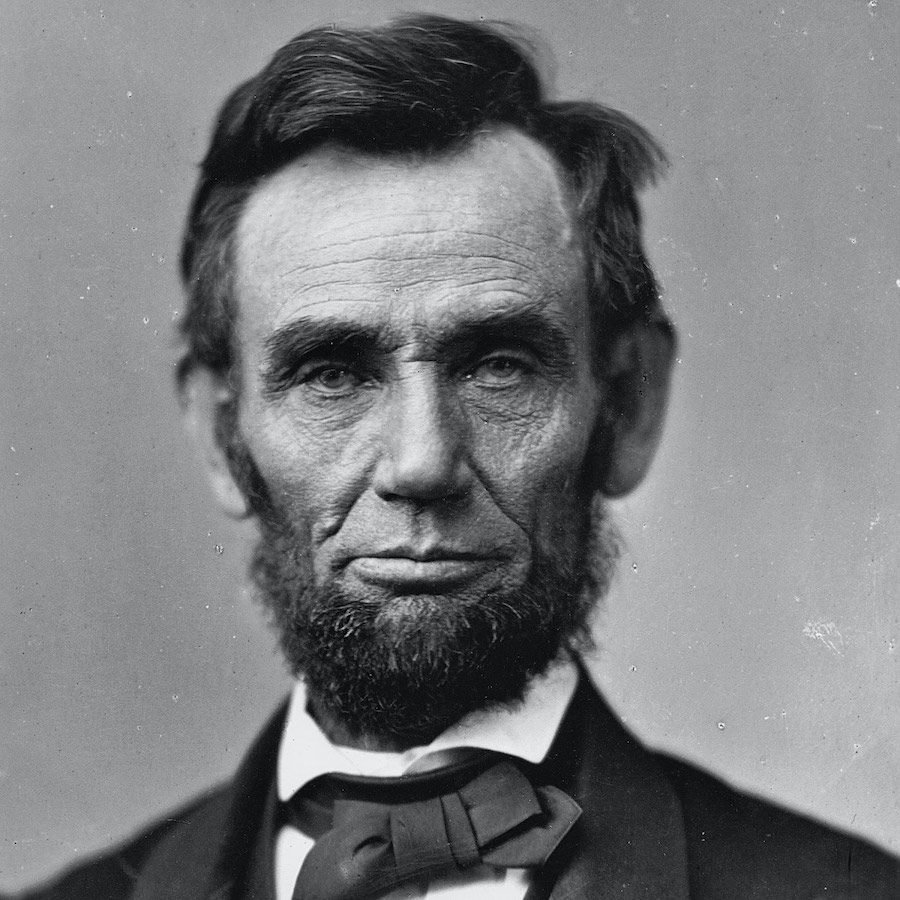
The son of a Kentucky frontiersman, Lincoln had to struggle for a living and for learning. Five months before receiving his party's nomination for President, he sketched his life:
I was born Feb. 12, 1809, in Hardin County, Kentucky. My parents were both born in Virginia, of undistinguished families–second families, perhaps I should say. My mother, who died in my tenth year, was of a family of the name of Hanks... My father ... removed from Kentucky to ... Indiana, in my eighth year... It was a wild region, with many bears and other wild animals still in the woods. There I grew up... Of course when I came of age I did not know much. Still somehow, I could read, write, and cipher ... but that was all.
Lincoln made extraordinary efforts to attain knowledge while working on a farm, splitting rails for fences, and keeping store at New Salem, Illinois. He was a captain in the Black Hawk War, spent eight years in the Illinois legislature, and rode the circuit of courts for many years. His law partner said of him, "His ambition was a little engine that knew no rest."
He married Mary Todd, and they had four boys, only one of whom lived to maturity. In 1858 Lincoln ran against Stephen A. Douglas for Senator. He lost the election, but in debating with Douglas he gained a national reputation that won him the Republican nomination for President in 1860.
As President, he built the Republican Party into a strong national organization. Further, he rallied most of the northern Democrats to the Union cause. On January 1, 1863, he issued the Emancipation Proclamation that declared forever free those slaves within the Confederacy.
Lincoln never let the world forget that the Civil War involved an even larger issue. This he stated most movingly in dedicating the military cemetery at Gettysburg: "that we here highly resolve that these dead shall not have died in vain–that this nation, under God, shall have a new birth of freedom–and that government of the people, by the people, for the people, shall not perish from the earth."
Lincoln won re-election in 1864, as Union military triumphs heralded an end to the war. In his planning for peace, the President was flexible and generous, encouraging Southerners to lay down their arms and join speedily in reunion.
The spirit that guided him was clearly that of his Second Inaugural Address, now inscribed on one wall of the Lincoln Memorial in Washington, D. C.: "With malice toward none; with charity for all; with firmness in the right, as God gives us to see the right, let us strive on to finish the work we are in; to bind up the nation's wounds.... "
On Good Friday, April 14, 1865, Lincoln was assassinated at Ford's Theatre in Washington by John Wilkes Booth, an actor, who somehow thought he was helping the South. The opposite was the result, for with Lincoln's death, the possibility of peace with magnanimity died.
https://www.whitehouse.gov/about-the-white-house/presidents/abraham-lincoln

The legend has been around for decades, ever since someone glanced at the back of Lincoln's head from a certain side angle and noticed it. What they saw back then is what a lot of people see now, and that is what appears to be the face of Confederate General Robert E. Lee protruding outward, facing the back wall.
It could be an illusion or how the lights reflects off of the marble, but there definitely does seem to be something going on there. The "shape" seems to have a nose, forehead, cheeks, beard, closed eyes, and a mouth, and the lock of Lincoln's hair that forms the nose is not replicated anywhere else on the back of his head—it would be odd for such skilled sculptors to just leave some hair sticking out of the back of the president's head like that.

One urban legend about Daniel Chester French's sculpture is that the hands spell out Abraham Lincoln's initials in sign language. Lincoln's left hand supposedly forms an "A" while the right hand forms an "L." Although the Park Service denies the story, it's possible that French did indeed intend it because French was familiar with sign language.
http://gurneyjourney.blogspot.com/2012/02/lincoln-memorial.html
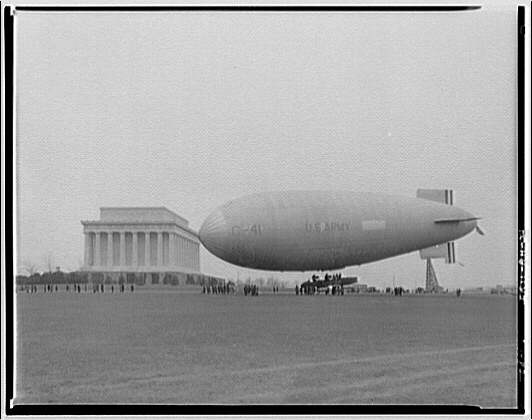
In 1930 the U.S. Army landed a blimp at the memorial in honor of Lincoln's birthday.
The Lincoln Memorial is a US national memorial built to honor the 16th president of the United States, Abraham Lincoln.Lincoln Memorial:
- It is on the western end of the National Mall in Washington, D.C.
- It is in the form of a neoclassical temple.
- The memorial's architect was Henry Bacon.
- The designer of the memorial interior's large central statue, Abraham Lincoln (1920), was Daniel Chester French.
- The Lincoln statue was carved by the Piccirilli brothers.
- The painter of the interior murals was Jules Guerin.
- The epithet above the statue was written by Royal Cortissoz.
- Dedicated in May 1922.
The building is in the form of a Greek Doric temple and contains a large seated sculpture of Abraham Lincoln and inscriptions of two well-known speeches by Lincoln:
- The Gettysburg Address (November 19, 1863)
- His second inaugural address (March 4, 1865)
The memorial has been the site of many famous speeches, including Martin Luther King Jr.'s "I Have a Dream" speech delivered on August 28, 1963The memorial is open to the public 24 hours a day, and more than 7 million people visit it annually



